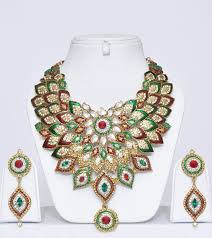Costume Jewellery
Costume jewelry is considered a discrete category of fashion accessory, and displays many characteristics of a self-contained industry. Costume jewelry manufacturers are located throughout the world, with a particular concentration in parts of China and India, where entire city-wide and region-wide economies are dominated by the trade of these goods.
There has been considerable controversy in the United States and elsewhere about the lack of regulations in the manufacture of such jewelry—these range from human rights issues surrounding the treatment of labor, to the use of manufacturing processes in which small, but potentially harmful, amounts of toxic metals are added during production. In 2010, the Associated Press released the story that toxic levels of the metal cadmium. were found in children’s jewelry. An AP investigation found some pieces contained more than 80 percent of cadmium.. The wider issues surrounding imports, exports, trade laws, and globalization also apply to the costume jewelry trade. check out for Similarities Of Costume & Fashion Jewellery
Costume jewelry, trinkets, fashion jewelry, junk jewelry, fake jewelry, or fallalery is jewelry manufactured as ornamentation to complement a particular fashionable costume or garment as opposed to “real” (fine) jewelry which may be regarded primarily as collectibles, keepsakes, or investments.
History of Costume Jewellery
Costume jewelry was also made popular by various designers in the mid-20th century. Some of the most remembered names in costume jewelry include both the high and low priced brands: Crown Trifari, Dior, Chanel, Miriam Haskell, Monet, Napier, Corocraft, Coventry, and Kim Craftsmen. check out Imitation Jewellery Online
A significant factor in the popularization of costume jewelry was the Hollywood movie. The leading female stars of the 1940s and 1950s often wore and then endorsed the pieces produced by a range of designers. If you admired a necklace worn by Bette Davis in The Private Lives of Elizabeth and Essex, you could buy a copy from Joseff of Hollywood, who made the original. Stars such as Vivien Leigh, Elizabeth Taylor and Jane Russell appeared in adverts for the pieces and the availability of the collections in shops such as Woolworth made it possible for ordinary women to own and wear such jewelry.
Coco Chanel greatly popularized the use of faux jewelry in her years as a fashion designer, bringing costume jewelry to life with gold and faux pearls. Kenneth Jay Lane has since the 1960s been known for creating unique pieces for Jackie Onassis, Elizabeth Taylor, Diana Vreeland, and Audrey Hepburn. He is probably best known for his three-strand faux pearl necklace worn by Barbara Bush to her husband’s inaugural ball.
In many instances, high-end fashion jewelry has achieved a “collectible” status, and increases in value over time. Today, there is a substantial secondary market for vintage fashion jewelry. The main collecting market is for ‘signed pieces’, that is pieces which have the maker’s mark, usually stamped on the reverse. Amongst the most sought after are Miriam Haskell, Coro, Butler and Wilson, Crown Trifari and Sphinx. However, there is also demand for good quality ‘unsigned’ pieces, especially if they are of an unusual design.
Conclusion
costume jewelry from manufacturers and typically import or export it to wholesale distributors and suppliers who deal directly with retailers. Wholesale costume jewelry merchants would traditionally seek out new suppliers at trade shows. As the Internet has become increasingly important in global trade, the trade-show model has changed. Retailers can now select from a large number of wholesalers with sites on the World Wide Web. Some of these sites also market directly to consumers, who can purchase costume jewelry at greatly reduced prices. Some of these sites include fashion jewelry as a separate category, while some use this term in favor of costume jewelry.
